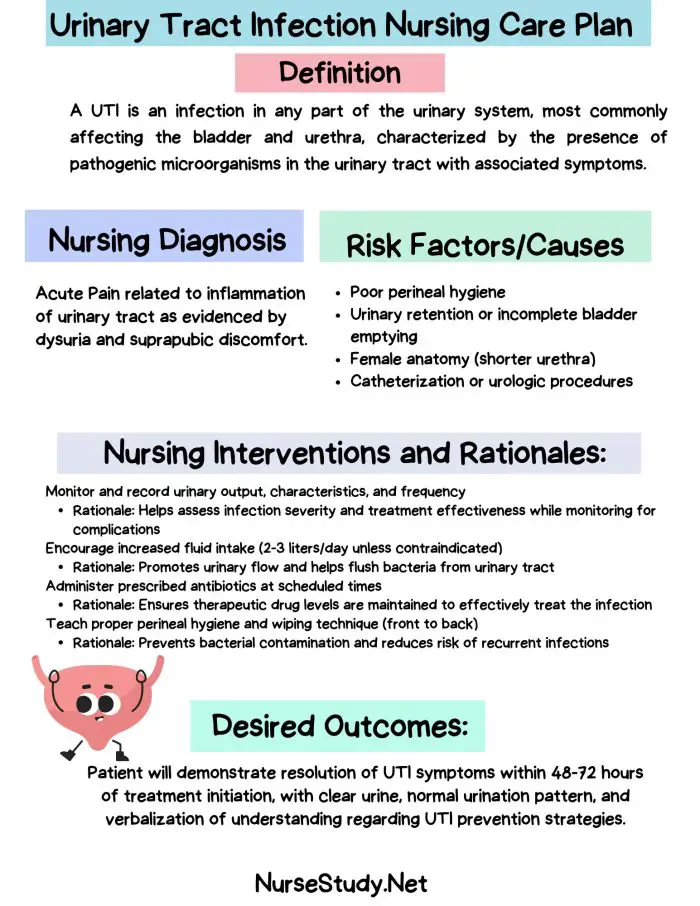Urinary tract infections (UTIs) are among the most common bacterial infections encountered in clinical practice. As a nurse, understanding Urinary Tract Infection UTI nursing diagnosis, treatment, and care is crucial for providing optimal patient outcomes.
Understanding Urinary Tract Infections
A urinary tract infection occurs when bacteria, typically Escherichia coli, invade any part of the urinary system, including the urethra, bladder, ureters, or kidneys. UTIs are particularly prevalent in women due to their shorter urethra, but they can affect individuals of all ages and genders.
Risk Factors for UTIs
Several factors can increase the risk of developing a UTI:
- Female anatomy
- Sexual activity
- Use of certain types of birth control
- Menopause
- Urinary tract abnormalities
- Blockages in the urinary tract (e.g., kidney stones)
- Catheter use
- A suppressed immune system
- Diabetes
Nursing Assessment for UTIs
A thorough nursing assessment is the foundation for accurate diagnosis and effective treatment of UTIs. This assessment should include both subjective and objective data collection.
Subjective Data Collection
During the patient interview, gather information about:
- Presenting symptoms (dysuria, frequency, urgency)
- Onset and duration of symptoms
- Any previous UTIs and their treatment
- Recent sexual activity
- Use of contraceptives
- Fluid intake habits
- Toileting habits and any changes
Objective Data Collection
Physical examination and diagnostic tests should include:
- Vital signs, including temperature
- Abdominal and flank palpation for tenderness
- Urine characteristics (color, clarity, odor)
- Urinalysis and urine culture
- Complete blood count (if systemic infection is suspected)
Nursing Diagnoses for UTIs
Based on the assessment data, nurses can formulate appropriate nursing diagnoses. Here are five common nursing diagnoses for patients with UTIs, along with their related factors, interventions, rationales, and desired outcomes:
1. Acute Pain
Nursing Diagnosis Statement: Acute Pain related to inflammation of the urinary tract as evidenced by patient reports of burning sensation during urination and lower abdominal discomfort.
Related Factors/Causes:
- Inflammation of the urinary tract
- Bladder spasms
- Increased bladder pressure
Nursing Interventions and Rationales:
- Assess pain characteristics (location, intensity, duration) using a standardized pain scale.
Rationale: Provides a baseline for evaluating treatment effectiveness. - Administer prescribed analgesics and monitor their effectiveness.
Rationale: Reduces pain and discomfort associated with UTI. - Encourage increased fluid intake unless contraindicated.
Rationale: Helps flush bacteria from the urinary tract and dilutes urine, reducing irritation. - Teach relaxation techniques such as deep breathing.
Rationale: It can help manage pain and reduce anxiety associated with urination. - Apply warm compresses to the lower abdomen.
Rationale: Promotes comfort and may help relieve bladder spasms.
Desired Outcomes:
- Patient reports decreased pain intensity (pain score ≤3 on a 0-10 scale) within 24 hours.
- The patient demonstrates the use of non-pharmacological pain management techniques.
2. Impaired Urinary Elimination
Nursing Diagnosis Statement: Impaired Urinary Elimination related to urinary tract inflammation as evidenced by frequent urination, urgency, and incomplete bladder emptying.
Related Factors/Causes:
- Urinary tract inflammation
- Bladder irritation
- Urethral edema
Nursing Interventions and Rationales:
- Monitor urinary output, including frequency, volume, and characteristics.
Rationale: Provides data on urinary function and infection status. - Encourage regular voiding every 2-3 hours during waking hours.
Rationale: Promotes complete bladder emptying and reduces bacterial growth. - Teach double voiding technique (urinating, waiting a few minutes, then trying again).
Rationale: Ensures more complete bladder emptying. - Instruct on proper perineal hygiene, including wiping front to back.
Rationale: Reduces the risk of introducing bacteria into the urinary tract. - Encourage adequate hydration unless contraindicated.
Rationale: Promotes urinary flushing and dilutes urine, reducing irritation.
Desired Outcomes:
- The patient demonstrates improved urinary elimination pattern within 48 hours.
- Patient verbalizes understanding of techniques to promote complete bladder emptying.
3. Risk for Infection (Sepsis)
Nursing Diagnosis Statement: Risk for Infection (Sepsis) related to current urinary tract infection and potential ascending infection.
Related Factors/Causes:
- Presence of pathogenic organisms in the urinary tract
- Potential for bacterial spread to the bloodstream
- Compromised immune system (if applicable)
Nursing Interventions and Rationales:
- Monitor vital signs, especially temperature, every 4 hours.
Rationale: Early detection of systemic infection signs. - Administer prescribed antibiotics as scheduled.
Rationale: Treats the underlying infection and prevents complications. - Obtain urine and blood cultures as ordered before starting antibiotics.
Rationale: Identifies causative organisms and guides appropriate antibiotic therapy. - Educate the patient on signs and symptoms of worsening infection to report.
Rationale: Promotes early intervention if condition deteriorates. - Encourage proper hand hygiene for patient and caregivers.
Rationale: Reduces the risk of introducing additional pathogens.
Desired Outcomes:
- Patient remains afebrile and shows no signs of systemic infection throughout treatment.
- The patient verbalizes understanding of infection signs to report.
4. Deficient Knowledge
Nursing Diagnosis Statement: Deficient Knowledge related to lack of information about UTI prevention and management as evidenced by the patient’s questions and misconceptions about the condition.
Related Factors/Causes:
- Lack of exposure to UTI prevention strategies
- Misunderstandings about UTI causes and treatment
- Cognitive limitations (if applicable)
Nursing Interventions and Rationales:
- Assess patient’s current knowledge about UTIs and their prevention.
Rationale: Identifies gaps in knowledge and guides education. - Provide education on UTI causes, symptoms, treatment, and prevention.
Rationale: Increases patient’s understanding and promotes self-care. - Teach proper hygiene practices, including wiping front to back and urinating after sexual intercourse.
Rationale: Reduces risk of bacterial introduction to the urinary tract. - Discuss the importance of completing the full course of antibiotics.
Rationale: Ensures complete eradication of infection and prevents antibiotic resistance. - Provide written materials about UTI prevention for reference.
Rationale: Reinforces verbal education and provides ongoing resource.
Desired Outcomes:
- The patient verbalizes understanding of UTI prevention strategies within 24 hours.
- Patient demonstrates proper hygiene techniques before discharge.
5. Disturbed Sleep Pattern
Nursing Diagnosis Statement: Disturbed Sleep Pattern related to frequent urination and discomfort as evidenced by patient reports of nighttime awakenings and daytime fatigue.
Related Factors/Causes:
- Nocturia (frequent nighttime urination)
- Discomfort or pain associated with UTI
- Anxiety about urinary symptoms
Nursing Interventions and Rationales:
- Assess sleep patterns and factors affecting sleep.
Rationale: Identify specific sleep disturbances and guide interventions. - Encourage fluid intake earlier in the day and limit it before bedtime.
Rationale: Reduces nighttime urinary frequency while maintaining hydration. - Administer pain medication before bedtime if needed.
Rationale: Reduces discomfort that may disrupt sleep. - Teach relaxation techniques to use before sleep.
Rationale: Promotes relaxation and may improve sleep quality. - Ensure a comfortable sleep environment (quiet, dark, cool).
Rationale: Promotes optimal conditions for sleep.
Desired Outcomes:
- Patient reports improved sleep quality within 48 hours.
- The patient demonstrates the use of sleep-promoting strategies.
Patient Education and Prevention Strategies
Educating patients about UTI prevention is crucial for reducing recurrence. Key points to cover include:
- Proper hydration habits
- Urination practices (e.g., emptying the bladder, urinating after intercourse)
- Proper wiping technique (front to back)
- Avoiding irritating feminine products
- Wearing breathable, cotton underwear
- Taking showers instead of baths
- Considering alternative birth control methods if using spermicides or diaphragms
Conclusion
Nursing care for patients with UTIs requires a comprehensive approach that includes accurate assessment, appropriate diagnoses, and targeted interventions. By implementing these evidence-based practices, nurses can significantly improve patient outcomes, reduce complications, and enhance overall quality of care.
References
- Flores-Mireles, A. L., Walker, J. N., Caparon, M., & Hultgren, S. J. (2015). Urinary tract infections: Epidemiology, mechanisms of infection and treatment options. Nature Reviews Microbiology, 13(5), 269-284.
- Hooton, T. M. (2012). Clinical practice. Uncomplicated urinary tract infection. New England Journal of Medicine, 366(11), 1028-1037.
- Rowe, T. A., & Juthani-Mehta, M. (2013). Urinary tract infection in older adults. Aging Health, 9(5), 519-528.
- Gupta, K., Hooton, T. M., Naber, K. G., Wullt, B., Colgan, R., Miller, L. G., … & Wagenlehner, F. M. (2011). International clinical practice guidelines for the treatment of acute uncomplicated cystitis and pyelonephritis in women: A 2010 update by the Infectious Diseases Society of America and the European Society for Microbiology and Infectious Diseases. Clinical Infectious Diseases, 52(5), e103-e120.
- Herdman, T. H., & Kamitsuru, S. (Eds.). (2018). NANDA International Nursing Diagnoses: Definitions & Classification 2018-2020. Thieme.
- Bulechek, G. M., Butcher, H. K., Dochterman, J. M., & Wagner, C. M. (2018). Nursing Interventions Classification (NIC). Elsevier Health Sciences.
- Moorhead, S., Johnson, M., Maas, M. L., & Swanson, E. (2018). Nursing Outcomes Classification (NOC): Measurement of Health Outcomes. Elsevier Health Sciences.
- Dougherty, L., & Lister, S. (Eds.). (2015). The Royal Marsden Manual of Clinical Nursing Procedures. John Wiley & Sons.
- Potter, P. A., Perry, A. G., Stockert, P. A., & Hall, A. M. (2016). Fundamentals of Nursing. Elsevier Health Sciences.
- Smeltzer, S. C., Bare, B. G., Hinkle, J. L., & Cheever, K. H. (2010). Brunner & Suddarth’s Textbook of Medical-Surgical Nursing. Lippincott Williams & Wilkins.

